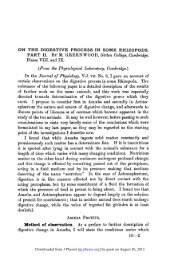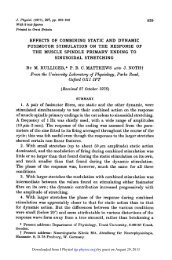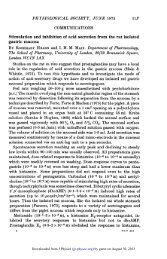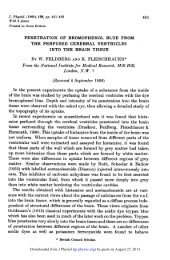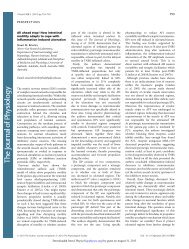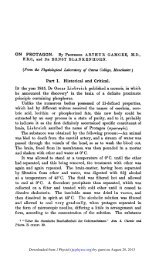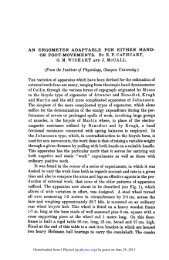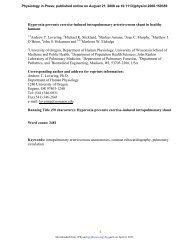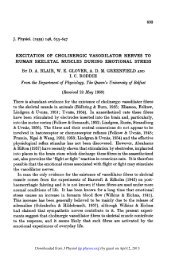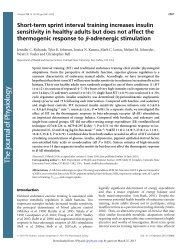The efficiency of contraction in rabbit skeletal muscle fibres ...
The efficiency of contraction in rabbit skeletal muscle fibres ...
The efficiency of contraction in rabbit skeletal muscle fibres ...
Create successful ePaper yourself
Turn your PDF publications into a flip-book with our unique Google optimized e-Paper software.
J. Physiol. 517.3 Efficiency <strong>of</strong> <strong>muscle</strong> <strong>contraction</strong><br />
851<br />
is <strong>in</strong>itially faster than at 2·7 ìm, it becomes slower after<br />
•0·5 s and the two traces cross over. <strong>The</strong> period <strong>of</strong> constant<br />
ATPase rate is a feature <strong>of</strong> the conditions used here (2·7 ìm<br />
and 12 °C). At the same sarcomere length, but at 15 °C, the<br />
period <strong>of</strong> steady ATPase rate is not so clear (data not<br />
shown). <strong>The</strong> ATPase rate <strong>in</strong> the first turnover is also<br />
sensitive to temperature. At a sarcomere length <strong>of</strong> 2·4 ìm,<br />
the ATPase rate <strong>in</strong>creased from 15·2 ± 0·7 to 19·8 ± 2·2 s¢<br />
(n = 5) when temperature was raised from 12 to 15 °C. At a<br />
sarcomere length <strong>of</strong> 2·7ìm, the same temperature rise<br />
caused the ATPase rate constant dur<strong>in</strong>g the first turnover<br />
to <strong>in</strong>crease from 10·5 ± 1·0 to 15·4 ± 1·8 s¢ (n = 5). A<br />
temperature rise <strong>of</strong> only 3 °C <strong>in</strong>creases the rate constants by<br />
factors <strong>of</strong> 1·3 and 1·47 for sarcomere lengths <strong>of</strong> 2·4 and<br />
2·7 ìm, respectively.<br />
DISCUSSION<br />
<strong>The</strong> ATPase rate constant dur<strong>in</strong>g the first turnover <strong>of</strong><br />
the ATPase<br />
<strong>The</strong> experiments were carried out on <strong>muscle</strong> <strong>fibres</strong> which<br />
had been treated with Triton X-100 as well as permeabilized<br />
by treatment with glycerol. In consequence, the ATPase<br />
activity rema<strong>in</strong><strong>in</strong>g <strong>in</strong> the <strong>muscle</strong> fibre is attributed solely to<br />
that <strong>of</strong> the actomyos<strong>in</strong>, as was shown previously (He et al.<br />
1997) on the basis <strong>of</strong> its sarcomere length dependence, Ca¥<br />
sensitivity and resistance to sarcoplasmic ATPase <strong>in</strong>hibitors.<br />
At 12 °C, the mean ATPase rates dur<strong>in</strong>g the first turnover<br />
were 10·3 s¢, when referred to an active site concentration<br />
<strong>of</strong> 0·14 mÒ, at a sarcomere length <strong>of</strong> 2·7 ìm and 15·2 s¢ at<br />
2·4 ìm. This latter value is slightly lower than that reported<br />
earlier (18·8 s¢) for psoas <strong>muscle</strong> <strong>fibres</strong> at 12 °C and a<br />
sarcomere length <strong>of</strong> 2·4 ìm, referred to an active site<br />
concentration <strong>of</strong> 0·15 mÒ (He et al. 1997). At 15 °C and a<br />
sarcomere length <strong>of</strong> 2·4 ìm, the ATPase rate dur<strong>in</strong>g the<br />
first turnover (19·8 s¢) is lower than the value <strong>of</strong> 31·5 s¢<br />
reported by He et al. (1998b). <strong>The</strong> high temperature<br />
sensitivity <strong>of</strong> the ATPase <strong>in</strong> this range and possible<br />
variations between <strong>fibres</strong> may expla<strong>in</strong> this difference.<br />
Decay <strong>of</strong> the ATPase rate constant follow<strong>in</strong>g<br />
photolysis <strong>of</strong> caged ATP<br />
He et al. (1997, 1998b) reported a high <strong>in</strong>itial ATPase rate<br />
which gradually decl<strong>in</strong>es dur<strong>in</strong>g the first few hundred<br />
milliseconds follow<strong>in</strong>g the photolytic release <strong>of</strong> ATP <strong>in</strong><br />
isometrically contract<strong>in</strong>g <strong>muscle</strong> <strong>fibres</strong>. He et al. (1998b)<br />
showed that the ATPase rate constant decayed gradually<br />
with time for both soleus and psoas <strong>muscle</strong> <strong>fibres</strong>, and that<br />
the decay was less marked <strong>in</strong> the presence <strong>of</strong> ADP. We show<br />
here that the decay <strong>in</strong> the ATPase rate constant depends on<br />
experimental conditions, <strong>in</strong> that, at a long sarcomere length<br />
(2·7 ìm) and at 12 °C, a period is seen dur<strong>in</strong>g which the<br />
ATPase rate constant rema<strong>in</strong>s relatively constant, as<br />
reported previously (Fig. 7<strong>of</strong>Heet al. 1997). Here, we use<br />
the period <strong>of</strong> steady ATPase to apply length changes, and<br />
to study the correspond<strong>in</strong>g changes <strong>in</strong> ATPase rate. <strong>The</strong><br />
conditions are therefore useful <strong>in</strong> that the observed changes<br />
Downloaded from J Physiol (<br />
jp.physoc.org)<br />
by guest on March 5, 2013<br />
<strong>in</strong> response to shorten<strong>in</strong>g are largely <strong>in</strong>dependent <strong>of</strong> the<br />
time when the shorten<strong>in</strong>g was applied. <strong>The</strong> difference <strong>in</strong><br />
behaviour seen at short and long sarcomere lengths <strong>in</strong> <strong>rabbit</strong><br />
<strong>fibres</strong> may be related to the extent and the time course <strong>of</strong><br />
fibre shorten<strong>in</strong>g seen at different lengths.<br />
Relationship between the ATPase rate constant<br />
dur<strong>in</strong>g the first turnover, <strong>in</strong> the isometric state and<br />
that seen dur<strong>in</strong>g filament slid<strong>in</strong>g<br />
We <strong>in</strong>vestigate below the effect <strong>of</strong> sarcomere shorten<strong>in</strong>g on<br />
the ATPase rate <strong>in</strong> the early phases <strong>of</strong> <strong>contraction</strong>, when<br />
the fibre length is constant. <strong>The</strong> high ATPase rate seen<br />
previously dur<strong>in</strong>g the first turnover (He et al. 1997, 1998b)<br />
was not thought to be attributable to sarcomere shorten<strong>in</strong>g<br />
<strong>in</strong> the <strong>in</strong>itial phases <strong>of</strong> <strong>contraction</strong>, but <strong>in</strong> those experiments<br />
sarcomere length measurements were not performed. Here,<br />
we show sarcomere length measurements from the same<br />
region <strong>of</strong> the fibre from which fluorescence signals are<br />
obta<strong>in</strong>ed. Although the diffraction signal <strong>in</strong>dicated that<br />
sarcomere length changes occurred follow<strong>in</strong>g the photolytic<br />
release <strong>of</strong> ATP, the signal was variable, sometimes show<strong>in</strong>g<br />
either lengthen<strong>in</strong>g or shorten<strong>in</strong>g. In most cases, the velocity<br />
<strong>of</strong> sarcomere shorten<strong>in</strong>g was slow and would not be<br />
expected to cause a large acceleration <strong>in</strong> the ATPase rate,<br />
unlike that seen <strong>in</strong> response to applied shorten<strong>in</strong>g. For<br />
shorten<strong>in</strong>g to account for the ATPase rate <strong>in</strong> the first<br />
turnover, it can be calculated from the hyperbola <strong>in</strong> Fig. 8<br />
that the shorten<strong>in</strong>g velocity dur<strong>in</strong>g the first turnover should<br />
be 0·22 ML s¢. <strong>The</strong> mean <strong>of</strong> the data <strong>in</strong> Fig. 3 (0·09 ML s¢)<br />
argues aga<strong>in</strong>st this possibility. However, the hyperbola <strong>in</strong><br />
Fig. 8 shows that shorten<strong>in</strong>g at a velocity <strong>of</strong> 0·09 ML s¢<br />
dur<strong>in</strong>g the nom<strong>in</strong>ally isometric phase <strong>of</strong> <strong>contraction</strong> is<br />
accompanied by an ATPase rate <strong>of</strong> 8 s¢, 22 % less than the<br />
measured value <strong>of</strong> 10·3 s¢. <strong>The</strong> difference between the<br />
observed ATPase rate constant and the ATPase rate<br />
constant which can be expla<strong>in</strong>ed by a period <strong>of</strong> shorten<strong>in</strong>g is<br />
thereforesmallanditcannotbeexcludedthatoursarcomere<br />
measurements fail to report precisely the nature <strong>of</strong><br />
sarcomere shorten<strong>in</strong>g <strong>in</strong> the field <strong>of</strong> view. For example, the<br />
laser diffraction signal provides a mean shorten<strong>in</strong>g velocity,<br />
but the presence <strong>of</strong> a small fraction <strong>of</strong> rapidly shorten<strong>in</strong>g<br />
sarcomeres may <strong>in</strong>crease the ATPase rate and not be<br />
detected by our apparatus. It may also be that some<br />
sarcomere jitter, or <strong>in</strong>dividual sarcomeres shorten<strong>in</strong>g rapidly<br />
at the expense <strong>of</strong> their neighbours accounts for an <strong>in</strong>crease<br />
<strong>in</strong> ATPase rate. More recent experiments us<strong>in</strong>g videomicroscopy<br />
<strong>of</strong> <strong>muscle</strong> <strong>fibres</strong> dur<strong>in</strong>g experiments have<br />
confirmed the accuracy <strong>of</strong> our laser diffraction method, but<br />
do not improve the spatial resolution <strong>of</strong> the measurements<br />
and do not exclude local shorten<strong>in</strong>g.<br />
However, if the ATPase rate dur<strong>in</strong>g the first turnover was<br />
higher than <strong>in</strong> the steady state because <strong>of</strong> transient<br />
shorten<strong>in</strong>g, the mean shorten<strong>in</strong>g velocity dur<strong>in</strong>g the first<br />
turnover (0·09 ML s¢, n = 29) would cause an <strong>in</strong>crease <strong>in</strong><br />
the ATPase rate from 5·1 to 8·0 s¢ (calculated from the<br />
hyperbola to the data shown <strong>in</strong> Fig. 8). This value is less



